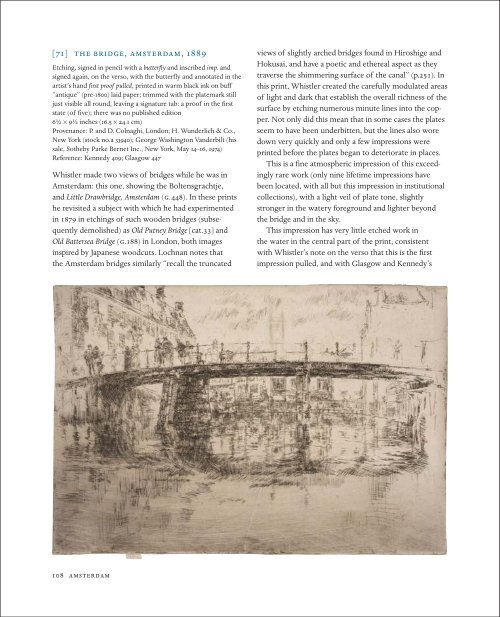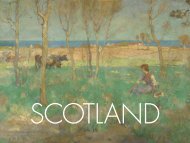Create successful ePaper yourself
Turn your PDF publications into a flip-book with our unique Google optimized e-Paper software.
[71] The Bridge, Amsterdam, 1889<br />
Etching, signed in pencil with a butterfly and inscribed imp. and<br />
signed again, on the verso, with the butterfly and annotated in the<br />
artist’s hand first proof pulled, printed in warm black ink on buff<br />
“antique” (pre-1800) laid paper; trimmed with the platemark still<br />
just visible all round, leaving a signature tab: a proof in the first<br />
state (of five); there was no published edition<br />
6 1/2 x 9 1/2 inches (16.5 x 24.1 cm)<br />
Provenance: P. and D. Colnaghi, London; H. Wunderlich & Co.,<br />
New York (stock no.a 33940); George Washington Vanderbilt (his<br />
sale, Sotheby Parke Bernet Inc., New York, May 14–16, 1974)<br />
Reference: Kennedy 409; Glasgow 447<br />
Whistler made two views of bridges while he was in<br />
Amsterdam: this one, showing the Boltensgrachtje,<br />
and Little Drawbridge, Amsterdam (g.448). In these prints<br />
he revisited a subject with which he had experimented<br />
in 1879 in etchings of such wooden bridges (subsequently<br />
demolished) as Old Putney Bridge [cat.33] and<br />
Old Battersea Bridge (g.188) in London, both images<br />
inspired by Japanese woodcuts. Lochnan notes that<br />
the Amsterdam bridges similarly “recall the truncated<br />
views of slightly arched bridges found in Hiroshige and<br />
Hokusai, and have a poetic and ethereal aspect as they<br />
traverse the shimmering surface of the canal” (p.251). In<br />
this print, Whistler created the carefully modulated areas<br />
of light and dark that establish the overall richness of the<br />
surface by etching numerous minute lines into the copper.<br />
Not only did this mean that in some cases the plates<br />
seem to have been underbitten, but the lines also wore<br />
down very quickly and only a few impressions were<br />
printed before the plates began to deteriorate in places.<br />
This is a fine atmospheric impression of this exceedingly<br />
rare work (only nine lifetime impressions have<br />
been located, with all but this impression in institutional<br />
collections), with a light veil of plate tone, slightly<br />
stronger in the watery foreground and lighter beyond<br />
the bridge and in the sky.<br />
This impression has very little etched work in<br />
the water in the central part of the print, consistent<br />
with Whistler’s note on the verso that this is the first<br />
impression pulled, and with Glasgow and Kennedy’s<br />
description of the first state of this print. Instead of the<br />
line work, Whistler has left waves of carefully wiped<br />
plate tone to represent the movement and shading of the<br />
water.<br />
In this early state, the bridge railing in the center and<br />
shadow work in the buildings at the left have not yet<br />
been completed. In the later states Whistler gradually<br />
added complex lines of additional shading and crosshatching<br />
to the water and across the sky and further<br />
defined the figures and other details. In this state the<br />
lines are drawn with an exquisite delicacy that appears to<br />
describe a sophisticated surface abstraction as much as a<br />
specific city scene.<br />
[72] Bridge, Amsterdam, 1889<br />
Etching, signed in pencil with a butterfly and inscribed imp.; also<br />
signed in pencil on the verso with a butterfly and numbered<br />
11, printed in brown ink on thin laid paper; trimmed on the<br />
platemark, leaving a signature tab; there was no published edition<br />
6 1/2 x 9 1/2 inches (16.5 x 24.1 cm)<br />
Provenance: Vivian and Meyer P. Potamkin, Philadelphia; sale,<br />
Sotheby’s, New York, May 11, 1989, lot 302 (the catalogue entry<br />
mentions a note on the mat which identifies this impression as<br />
formerly owned by Walter Steuben Carter and illustrated in the<br />
Kennedy catalogue; comparison with Kennedy’s plate for his third<br />
state and this impression, however, shows that the illustrated print<br />
is not identical with the present sheet)<br />
Reference: Kennedy 409; Glasgow 447<br />
This impression is included in the Glasgow inventory,<br />
K.4090301; only about eleven lifetime impressions in all<br />
states are known (three were also printed posthumously<br />
by Nathaniel Sparks). Ours is a very fine, shimmering<br />
impression of this great rarity.<br />
Although the structure of the composition was established<br />
in the first state, Whistler’s reworking of the plate<br />
through all five states, with the addition of the vigorous<br />
lines in the sky and water and more densely shaded<br />
figures and buildings, ultimately produced a darker,<br />
stormier version of a scene that initially seemed quite<br />
peaceful.<br />
108 AMSTERDAM james mcneill whistler: prints 109



